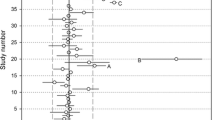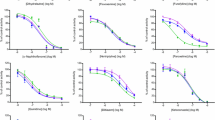Abstract
Cocktail substrates are useful in investigating drug–drug interactions (DDI) that can rapidly identify the cytochrome P450 (CYP) isoforms that interact with test drugs. In this study, we developed and validated five probe drugs for CYP1A, CYP2B, CYP2C, CYP2D, and CYP3A using LC–MS/MS to determine CYP activities in mice. The five probe substrates were caffeine (2 mg/kg), bupropion (30 mg/kg), omeprazole (4 mg/kg), dextromethorphan (40 mg/kg), and midazolam (2 mg/kg) for CYP1A, CYP2B, CYP2C, CYP2D, and CYP3A, respectively. The cocktail substrates were orally administered to male 5-week-old ICR mice over 0–240 min. The analytical method was validated; it showed high selectivity, linearity, and acceptable accuracy. We confirmed the lack of interaction of this cocktail in the control state (no effect of CYP inducer or inhibitor) and suggested AUCratio (metabolite/substrate) as a unit to evaluate DDI in vivo. In addition, the cocktail assay was applied for the determination of pharmacokinetic parameters against phenobarbital as a selective CYP2B inducer and ketoconazole as a strong CYP3A inhibitor. The concentration of cocktail substrates and the LC–MS/MS method were optimized. In conclusion, we developed a simultaneous and comprehensive analysis system for predicting potential DDI in mice.



Similar content being viewed by others
Change history
13 November 2018
The author would like to change conflict of interest statement of the online published article.
13 November 2018
The author would like to change conflict of interest statement of the online published article.
References
Aidasani D, Zaya MJ, Malpas PB, Locuson CW (2008) In vitro drug-drug interaction screens for canine veterinary medicines: evaluation of cytochrome P450 reversible inhibition. Drug Metab Dispos 36:1512–1518
Araujo MS, Martins-Filho OA, Pereira ME, Brener ZA (2000) A combination of benznidazole and ketoconazole enhances efficacy of chemotherapy of experimental Chagas’ disease. J Antimicrob Chemother 45(6):819–824
Bogaards JJP, Bertrand M, Jackson P, Oudshoorn MJ, Weaver RJ, Van Bladeren PJ, Walther B (2000) Determining the best animal model for human cytochrome P450 activities: a comparison of mouse, rat, rabbit, dog, micropig, monkey and man. Xenobiotica 30:1131–1152
Bu HZ, Magis L, Knuth K, Teitelbaum P (2000) High-throughput cytochrome P450 (CYP) inhibition screening via cassette probe-dosing strategy. I. Development of direct injection/on-line guard cartridge extraction/tandem mass spectrometry for the simultaneous detection of CYP probe substrates and their metabolites. Rapid Commun Mass Spectrom 14:1619–1624
Chen SZ, Pan PP, Shen LB, Xu SS, Dai DP, Geng PW, Cai J, Cai JP, Hu GX (2014) Drug-drug interaction of losartan and glimepiride metabolism by recombinant microsome CYP2C9* 1, 2C9* 3, 2C9* 13, and 2C9* 16 in vitro. Int J Clin Pharmacol Ther 52:732–738
Cheng Y, Huang Y, Tian Y, Xu L, Liu GQ, Zahng ZJ (2013) Assessment of the effects of Radix bupleuri and vinegar-baked Radix bupleuri on cytochrome 450 activity by a six-drug cocktail approach. Chin J Nat Med 11:302–308
de Andres F, LLerena A (2016) Simultaneous determination of cytochrome P450 oxidation capacity in humans: a review on the phenotyping cocktail approach. Curr Pharm Biotechnol 17:1159–1180
Desai PB, Duan JZ, Zhu YW, Kouzi S (1998) Human liver microsomal metabolism of paclitaxel and drug interactions. Eur J Drug Metab Pharmacokinet 23:417–424
Emes RD (2003) Comparison of the genomes of human and mouse lays the foundation of genome zoology. Hum Mol Genet 12:701–709
Hefner G, Unterecker S, Ben-Omar N, Wolf M, Falter T, Hiemke C, Haen E (2015) Prevalence and type of potential pharmacokinetic drug-drug interactions in old aged psychiatric patients. Contemp Behav Health Care 1:3–10
Higashikawa F, Murakami T, Kaneda T, Takano M (1999) In-vivo and in vitro metabolic clearance of midazolam, a cytochrome P450 3A substrate, by the liver under normal and increased enzyme activity in rats. J Pharm Pharmacol 51:405–410
Kim HJ, Choi ES, Wade AE (1990) Effect of dietary fat on the induction of hepatic microsomal cytochrome P450 isozymes by phenobarbital. Biochem Pharmacol 39:1423–1430
Kot M, Daniel WA (2008) Caffeine as a marker substrate for testing cytochrome P450 activity in human and rat. Pharmacol Rep 60:789–797
Lammers LA, Achterbergh R, Pistorius MC, Bijleveld Y, De Vries EM, Boelen A, Klumpen HJ, Romijn JA, Mathot RA (2016) Quantitative method for simultaneous analysis of a 5-probe cocktail for cytochrome P450 enzymes. Ther Drug Monit 38:761–768
Martignoni M, Groothuis GM, De Kanter R (2006) Species differences between mouse, rat, dog, monkey and human CYP-mediated drug metabolism, inhibition and induction. Expert Opin Drug Metab Toxicol 2:875–894
Mo SL, Liu YH, Duan W, Wei MQ, Kanwar JR, Zhou SF (2009) Substrate specificity, regulation, and polymorphism of human cytochrome P450 2B6. Curr Drug Metab 10:730–753
Nelson DR, Zeldin DC, Hoffman SM, Maltais LJ, Wain HM, Nebert ND (2004) Comparison of cytochrome P450 (CYP) genes from the mouse and human genomes, including nomenclature recommendations for genes, pseudogenes and alternative-splice variants. Pharmacogenetics 14:1–18
Polasek TM, Lin FP, Miners JO, Doogue MP (2011) Perpetrators of pharmacokinetic drug-drug interactions arising from altered cytochrome P450 activity: a criteria-based assessment. Br J Clin Pharmacol 71:727–736
Rendic S, Di Carlo FJ (1997) Human cytochrome P450 enzymes: a status report summarizing their reactions, substrates, inducers, and inhibitors. Drug Metab Rev 29:413–580
Ryu JY, Song IS, Sunwoo YE, Shon JH, Liu KH, Cha IJ, Shin JG (2007) Development of the “Inje cocktail” for high-throughput evaluation of five human cytochrome P450 isoforms in vivo. Clin Pharmacol Ther 82:531–540
Sim J, Nam W, Lee D, Lee S, Hungchan O, Joo J, Liu KH, Han JY, Ki SH, Jeong TC, Lee T (2015) Selective induction of hepatic cytochrome P450 2B activity by leelamine in vivo, as a potent novel inducer. Arch Pharmacal Res 38(5):725–733
Stewart NA, Buch SC, Conrads TP, Branch RA (2011) A UPLC-MS/MS assay of the “Pittsburgh cocktail”: six CYP probe-drug/metabolites from human plasma and urine using stable isotope dilution. Analyst 136:605–612
Tanaka S, Uchida S, Inui N, Takeuchi K, Watanabe H, Namiki N (2014) Simultaneous LC-MS/MS analysis of the plasma concentrations of a cocktail of 5 cytochrome P450 substrate drugs and their metabolites. Biol Pharm Bull 37:18–25
Turpault S, Brian W, Van Horn R, Santoni A, Poitiers F, Donazzolo Y, Boulenc X (2009) Pharmacokinetic assessment of a five-probe cocktail for CYPs 1A2, 2C9, 2C19, 2D6 and 3A. Br J Clin Pharmacol 68:928–935
Uchida S, Tanaka S, Namiki N (2014) Simultaneous and comprehensive in vivo analysis of cytochrome P450 activity by using a cocktail approach in rats. Biopharm Drug Dispos 35:228–236
Vandenbrink BM, Foti RS, Rock DA, Wienkers LC, Wahlstrom JL (2012) Prediction of CYP2D6 drug interactions from in vitro data: evidence for substrate-dependent inhibition. Drug Metab Dispos 40:47–53
Vermeer LM, Isringhausen CD, Ogilvie BW, Buckley DB (2016) Evaluation of ketoconazole and its alternative clinical CYP3A4/5 inhibitors as inhibitors of drug transporters: the in vitro effects of ketoconazole, ritonavir, clarithromycin, and itraconazole on 13 clinically-relevant drug transporters. Drug Metab Dispos 44:453–459
Wang JF, Chou KC (2010) Molecular modeling of cytochrome P450 and drug metabolism. Curr Drug Metab 11:342–346
Wu D, Otton SV, Kalow W, Sellers EM (1995) Effects of route of administration on dextromethorphan pharmacokinetics and behavioral response in the rat. J Pharmacol Exp Ther 274(3):1431–1437
Xiaoping L, Zhong F, Tan X (2013) Cytochrome P450 2C8 and drug metabolism. Curr Top Med Chem 13:2241–2253
Yu AM, Haining RL (2006) Expression, purification, and characterization of mouse CYP2d22. Drug Metab Dispos 34:1167–1174
Zambon S, Fontana S, Kajbaf M (2010) Evaluation of cytochrome P450 inhibition assays using human liver microsomes by a cassette analysis/LC-MS/MS. Drug Metab Lett 4:120–128
Zhou SF, Chan E, Zhou ZW, Xue CC, Lai X, Duan W (2009a) Insights into the structure, function, and regulation of human cytochrome P450 1A2. Curr Drug Metab 10:713–729
Zhou SF, Liu JP, Lai XS (2009b) Substrate specificity, inhibitors and regulation of human cytochrome P450 2D6 and implications in drug development. Curr Med Chem 16:2661–2805
Acknowledgements
This work was supported by the Korea Institute of Planning and Evaluation for Technology in Food, Agriculture, Forestry and Fisheries (IPET) through the Export Promotion Technology Development Program, fund from the Ministry of Agriculture, Food and Rural Affairs (MAFRA) (Grant Number 316017-3), and by the National Research Foundation (NRF) Grant funded by the Korean government (MSIP) (2015R1A2A2A01004286).
Author information
Authors and Affiliations
Corresponding authors
Ethics declarations
Conflict of interest
We wish to confirm that there are no known conflicts of interest associated with this publication and there has been no significant financial support for this work that could have influenced its outcome.
Electronic supplementary material
Below is the link to the electronic supplementary material.
Rights and permissions
About this article
Cite this article
Jo, J.J., Jo, J.H., Kim, S. et al. Development of a simultaneous LC–MS/MS method to predict in vivo drug–drug interaction in mice. Arch. Pharm. Res. 41, 450–458 (2018). https://doi.org/10.1007/s12272-018-1012-8
Received:
Accepted:
Published:
Issue Date:
DOI: https://doi.org/10.1007/s12272-018-1012-8




